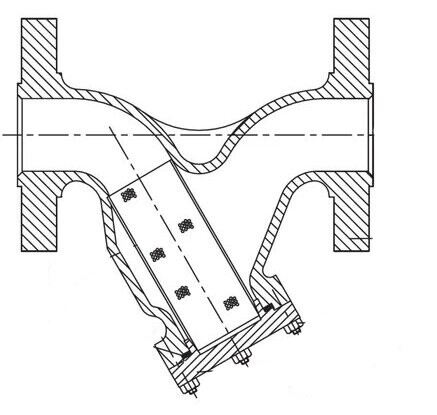Exploring the Significance of Y Strainers in Fluid Control Systems
Feb 26, 2024
In fluid conveyance systems, Y strainers play a vital role in filtering out impurities and ensuring smooth operation. Positioned at the inlet ends of pressure reducing valves, relief valves, and level control valves, these filters are renowned for their efficient filtration capabilities and robust design. This article aims to explore the structural features, operational benefits, and diverse industrial applications of Y strainers, highlighting their significance in achieving effective fluid control across various sectors.

Structural Features and Operating Principles
Y strainers typically consist of a cylindrical body, stainless steel filter mesh, drain section, transmission device, and electrical control component. Engineered to capture particles larger than the filter mesh, they promote unhindered fluid flow while facilitating easy maintenance. The operational principle involves the interception of impurities by the filter mesh, followed by periodic cleaning to uphold optimal filtration efficiency. Additionally, Y strainers employ various testing methods, such as the bubble point method and diffusion flow method, to ensure accurate and reliable performance.
Technological Advantages
Y strainers offer several technological advantages that make them essential components in fluid control systems across various industries. Here are some key advantages:
Y strainers play a pivotal role in industrial fluid control by effectively removing solid impurities from fluids, thereby ensuring the smooth operation of machinery and equipment. With their advanced design, efficient filtration, and technological advantages, Y strainers are indispensable components in various industrial applications, contributing to enhanced productivity and safety.

Structural Features and Operating Principles
Y strainers typically consist of a cylindrical body, stainless steel filter mesh, drain section, transmission device, and electrical control component. Engineered to capture particles larger than the filter mesh, they promote unhindered fluid flow while facilitating easy maintenance. The operational principle involves the interception of impurities by the filter mesh, followed by periodic cleaning to uphold optimal filtration efficiency. Additionally, Y strainers employ various testing methods, such as the bubble point method and diffusion flow method, to ensure accurate and reliable performance.
Technological Advantages
Y strainers offer several technological advantages that make them essential components in fluid control systems across various industries. Here are some key advantages:
1. Precision Filtration and Stable Fluid Quality
Y strainers offer high precision filtration, ensuring consistent fluid quality.
2. Efficient Cleaning Mechanisms
These filters feature efficient cleaning mechanisms, allowing for prolonged use without the need for replacement.
3. Responsive Control Systems
Y strainers boast responsive control systems adaptable to diverse filtration requirements.
4. Versatile Application Range
Suitable for various fluid qualities and usage scenarios, Y strainers find applications across diverse industrial sectors.
5. Continuous Operation
Y strainers can operate continuously during backwashing, ensuring uninterrupted production and reliability.
6. Minimal Backwashing Duration
The backwashing process of Y strainers is brief, minimizing water and energy consumption.
7. Compact Design
Y strainers are compactly designed, requiring minimal space and offering easy installation and mobility.
8. Low Maintenance Costs
With few wearing parts and low maintenance requirements, Y strainers incur minimal operational expenses.
9. Automatic Backwashing Functionality
Equipped with automatic backwashing capabilities, Y strainers effectively respond to fluctuations in fluid quality without manual intervention.
Y strainers offer high precision filtration, ensuring consistent fluid quality.
2. Efficient Cleaning Mechanisms
These filters feature efficient cleaning mechanisms, allowing for prolonged use without the need for replacement.
3. Responsive Control Systems
Y strainers boast responsive control systems adaptable to diverse filtration requirements.
4. Versatile Application Range
Suitable for various fluid qualities and usage scenarios, Y strainers find applications across diverse industrial sectors.
5. Continuous Operation
Y strainers can operate continuously during backwashing, ensuring uninterrupted production and reliability.
6. Minimal Backwashing Duration
The backwashing process of Y strainers is brief, minimizing water and energy consumption.
7. Compact Design
Y strainers are compactly designed, requiring minimal space and offering easy installation and mobility.
8. Low Maintenance Costs
With few wearing parts and low maintenance requirements, Y strainers incur minimal operational expenses.
9. Automatic Backwashing Functionality
Equipped with automatic backwashing capabilities, Y strainers effectively respond to fluctuations in fluid quality without manual intervention.
Y strainers play a pivotal role in industrial fluid control by effectively removing solid impurities from fluids, thereby ensuring the smooth operation of machinery and equipment. With their advanced design, efficient filtration, and technological advantages, Y strainers are indispensable components in various industrial applications, contributing to enhanced productivity and safety.
Next: Swing Check Valves: Structure, Operation and Maintenance Guide
Previous: Essential Tips for Forged Steel Gate Valve Operation and Maintenance
About Us
Categories
Useful Links
Our Contacts
Building 2, NO.59, Songshan Road, SND, Suzhou, China
